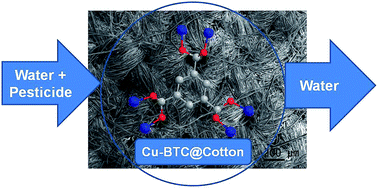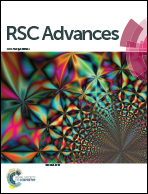Cu–BTC@cotton composite: design and removal of ethion insecticide from water†
Abstract
Pesticide removal from wastewater is of significant general benefit to protect of humans from the effect of pollution. Current study offers excellent material for organophosphate insecticide pollution remediation based on metal–organic frameworks (MOFs). A facile method was used to functionalize cotton fabric by assembly with Cu–BTC MOFs. The so-prepared Cu–BTC@cotton composite was characterized by X-ray diffraction, infrared spectroscopy, elemental analysis, and electron microscope. Cu–BTC was successfully bonded with cotton fabrics through interaction between Cu and cellulose functional groups. Adsorption of ethion as organophosphorus insecticide onto Cu–BTC@cotton composite was systematically studied. Binding sites of composite represented in cellulose functional groups and Cu of MOF were both linked with ethion via sulfur. The equilibrium adsorption isotherm proved that the adsorption of ethion insecticide was fitted well to the Langmuir model. The maximum sorption capacity of Cu–BTC@cotton composite reached 182 mg g−1 and the removal percent of ethion exceeded 97%. Furthermore, Cu–BTC@cotton composite is very stable and can be easily recycled using a simple organic solvent. After recycling five times, the adsorption efficiency of Cu–BTC@cotton composite was still very good and surpassing 85%. Therefore, Cu–BTC@cotton is a perfect sorbent to remove insecticides from wastewater with excellent efficiency.

- This article is part of the themed collection: Zeolites and 3D Porous Solids

 Please wait while we load your content...
Please wait while we load your content...